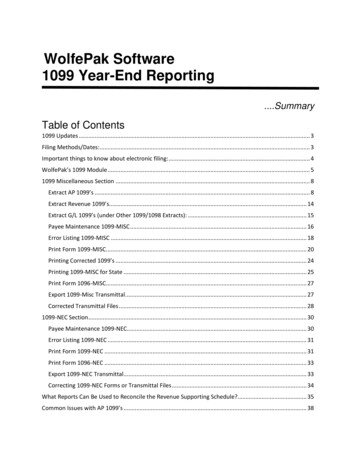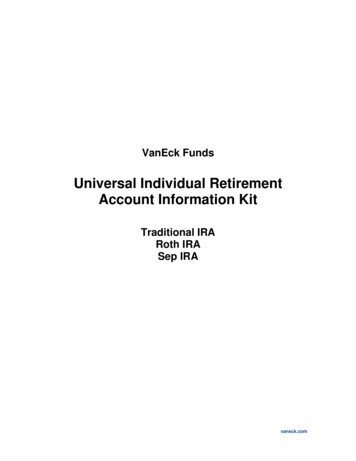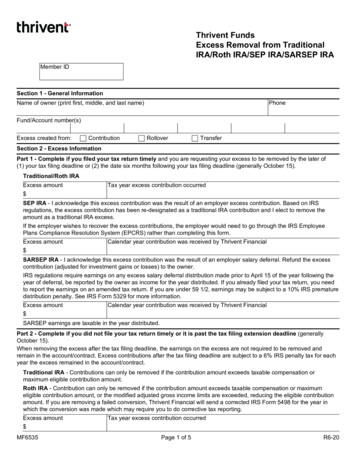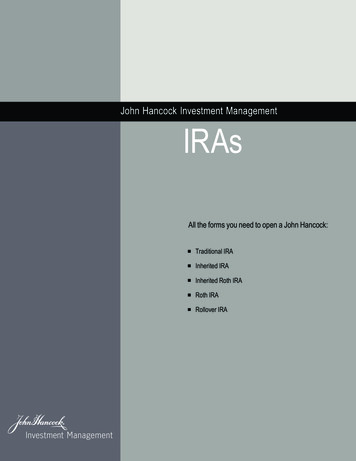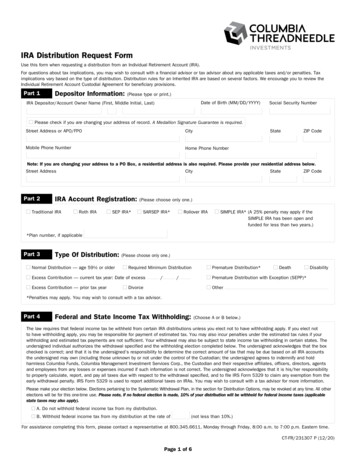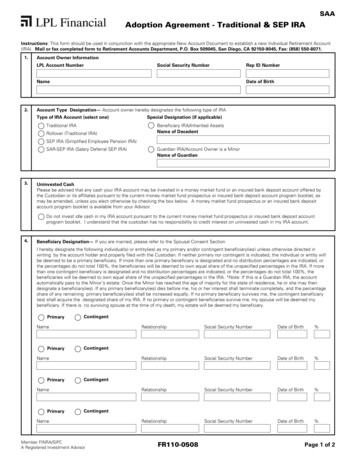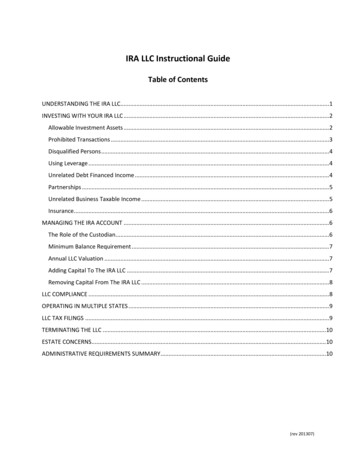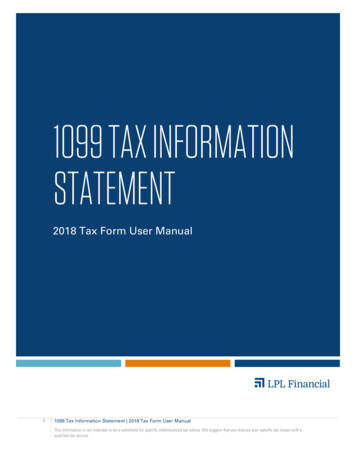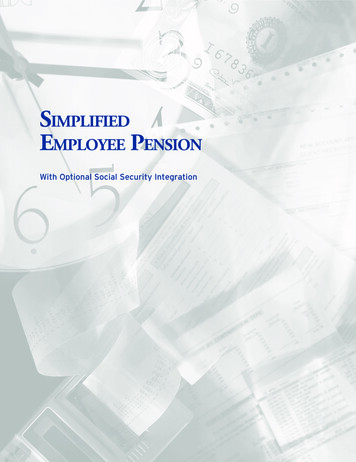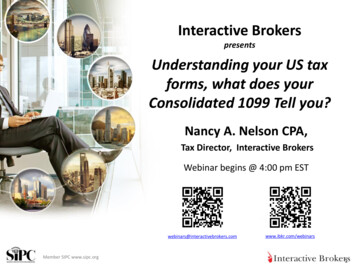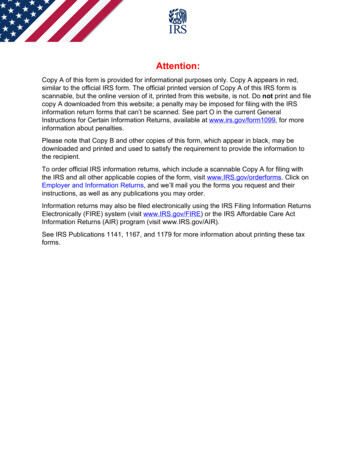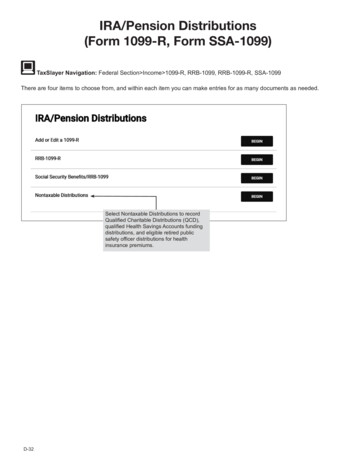
Transcription
IRA/Pension Distributions(Form 1099-R, Form SSA-1099)TaxSlayer Navigation: Federal Section Income 1099-R, RRB-1099, RRB-1099-R, SSA-1099There are four items to choose from, and within each item you can make entries for as many documents as needed.Select Nontaxable Distributions to recordQualified Charitable Distributions (QCD),qualified Health Savings Accounts fundingdistributions, and eligible retired publicsafety officer distributions for healthinsurance premiums.D-32
Form 1099-RTaxSlayer Navigation: Federal Section Income 1099-R, RRB-1099, RRB-1099-R, SSA-1099 Add or Edit a 1099R; or Keyword “R”Note: See the Box 7 Distribution Codes later in this tab for scope limitations.Box 2a will automatically fill in with the amount in Box 1. If a different amount is shown on the document, enter that amountdirectly. You may need to use the Simplified Method to calculate the taxable amount of the distribution if: Box 2a is zero or blank and an amount is shown in Box 9b. Box 1 and 2a contain the same amount and Taxable amount not determined box is marked.Refer to the Taxable Amount Not Determined and Form 1099-R Simplified Method sections later in this Tab.After completing the Simplified Method Worksheet or entering the Public Safety Officer Exclusion for Health Insurance Premiums, thetaxable portion of the distribution will carryover to Box 2a. Manual adjustments are required to make sure Box 2a reflects changes dueto rollovers, qualified charitable contributions, return of capital, etc.If a joint return,choose whothe documentbelongs to.EIN mustbe enteredaccurately.Incorrect EINis a commone-file reject.If marked, thetaxable amountwill not carry toForm 8880, Creditfor QualifiedRetirement SavingsContributions,line 4 as a currentyear distribution.See Tab G,NonrefundableCredits.If Simplified Method is required orif the taxpayer has public safetyofficer health insurance deduction,click here for worksheet.Box 2b indicates “Taxable amount notdetermined” and “Total distribution”.Mark exactly as shown on document.If Box 4 has anentry, ensure thatthe tax withheldis entered and iscorrect.D-33
Form 1099-R (continued)Box 5 on the document may be current year’s amount of employee contributions or insurance premiums(recovery of cost basis or investment in the contract). If Box 5 is the same as Box 1, none of thedistribution is taxable. If the payer has calculated the taxable amount of the pension in Box 2a, generallythe difference between Boxes 1 and 2a will appear in Box 5. If Box 5 is the amount of health insurancepremiums, (typically only on a CSA 1099-R) you must manually carry the amount to the Schedule A,Itemized Deductions, Medical or Dental Expenses.Box 7 is a required entry – Enter exactlyas shown on document. If IRA/SEP/Simple is marked, check to enter exactlyas on document. See Distribution CodesChart in this tab. The simplified methodcannot be used for code “D” or othernon-qualified plan distributions.Box 9b shows the totalemployee contributions andmay be needed if Box 2 hasno entry – usually requiresSimplified Method Worksheet(see Box 2a).D-34
Tax-Favorable Treatment of Coronavirus-RelatedRetirement DistributionsThe Coronavirus Aid, Relief, and Economic Security Act (CARES Act) of 2020, provides for expanded distribution optionsand favorable tax treatment for up to 100,000 coronavirus-related distributions from eligible retirement plans, as well asspecial rollover rules with respect to such distributions, to qualified individuals. Eligible retirement plans include certainemployer retirement plans, such as section 401(k) and 403(b) plans, and IRAs.Qualified IndividualsThese special provisions apple to a qualified individual only. A qualified individual is anyone who: is diagnosed, or whose spouse or dependent is diagnosed, with the virus SARS-CoV-2 or the coronavirus disease2019 (collectively, "COVID-19") by a test approved by the Centers for Disease Control and Prevention (including a testauthorized under the Federal Food, Drug, and Cosmetic Act); or experiences adverse financial consequences as a result of the individual, the individual's spouse, or a member of theindividual's household (that is, someone who shares the individual's principal residence): being quarantined, being furloughed or laid off, or having work hours reduced due to COVID-19; being unable to work due to lack of childcare due to COVID-19; closing or reducing hours of a business that they own or operate due to COVID-19; having pay or self-employment income reduced due to COVID-19; or having a job offer rescinded or start date for a job delayed due to COVID-19.The taxpayer will determine if they are a qualified individual. Coronavirus-related distributions are permitted without regardto the qualified individual's need for funds, and the amount of the distribution is not required to correspond to the extent ofthe adverse financial consequences experienced by the qualified individual.Distributions That Are Not Coronavirus RelatedThe following amounts are not coronavirus-related distributions. The taxpayer will need to determine if a distribution is orincludes any of the following:– corrective distributions of elective deferrals and employee contributions that are returned to the employee (togetherwith the income allocable thereto) (Form 1099-R, Box 7, code 8)– certain excess elective deferrals or contributions (Form 1099-R Box 7, code 8 )– loans that are treated as deemed distributions (Form 1099-R, Box 7, code L)– dividends paid on applicable employer securities (Form 1099-R, Box 7, code U)– the costs of current life insurance protection (Form 1099-R, Box 7, code 9)– prohibited allocations that are treated as deemed distributions (Form 1099-R, Box 7, code 5)– distributions that are permissible withdrawals from an eligible automatic contribution arrangement– distributions of premiums for accident or health insuranceDisaster-related distributions that are not coronavirus-related distributions are out of scope. Information on disaster-relateddistributions is available on irs.gov.Exception to Additional Tax on Early DistributionsCoronavirus-related distributions are not subject to the 10% (25% for SIMPLE IRAs) additional tax on early distributions.Use Form 5329 to claim exception code 12- Other if the coronavirus-related distribution is also an early distribution, but onno more than the 100,000 maximum.D-35
Tax-Favorable Treatment of Coronavirus-RelatedRetirement Distributions (continued)Three Year Ratable Inclusion in IncomeA CARES Act distribution may be included in income ratably over a three-year period, starting with the year in which thedistribution is received. Taxpayers may elect out of the 3-year ratable income inclusion. This election cannot be madeor changed after the timely filing of the individual's federal income tax return. All coronavirus-related distributions mustbe treated consistently - either all distribution must be included in income over a three year period or all are included inincome in the year of distribution. Each spouse who is a qualified individual will file Form 8915-E to make their election fortheir respective eligible distributions.RecontributionsA qualified individual who receives a coronavirus-related distribution that is eligible for tax-free rollover treatment ispermitted to be recontributed any portion of the distribution to the same plan or another eligible retirement plan (suchas an IRA) within 3 years from the day after the date of distribution. Not all coronavirus-related distributions qualify forrecontribution. These amounts are cannot be recontributed:– Any coronavirus-related distribution (whether from an employer retirement plan or an IRA) paid to a qualifiedindividual as a beneficiary of an employee or IRA owner (other than the surviving spouse of the employee or IRAowner).– Any distribution (other than from an IRA) that is one of a series of substantially equal periodic payments made (atleast annually) for:- A period of 10 years or more,- The individual’s life or life expectancy, or- The joint lives or joint life expectancies of the individual and the individual’s beneficiary.– Required minimum distributions.Thus, pensions are not eligible for recontribution. Since RMDs were waived for 2020, qualified individuals can recontributea distribution that would have been a 2020 RMD.A recontribution to an eligible retirement plan at any date before the individual’s federal income tax return is filed (thatis, by the due date, including extensions) will reduce the ratable portion of the coronavirus-related distribution thatis includible in gross income for that tax year. No election is needed and the taxpayer can decide how much, if any,to recontribute within the permitted 3 year period. If a recontribution exceeds that year’s ratable taxable amount, thetaxpayer can either carry back or carry forward the excess recontribution. Recontribution of an amount taxed in an earlieryear will necessitate an amended return.A recontribution of a coronavirus-related distribution will not be treated as a rollover contribution for purposes of the onerollover-per-year limitation.TaxSlayerQualified individuals will use Form 8915-E to desigate a distribution as a coronavirus-related distribution from an eligibleretirement plan. The individual will identify their coronavirus-related distributions (and allocate the 100,000 limitation,if it applies), elect or not elect the 3-year ratable inclusion in income, and show any recontributions made up throughthe timely filing date of the tax return. Form 5329 is used to claim the coronavirus-related distribution exception to theadditional tax on early distributions. Refer to Tab H.For more information refer to Coronavirus-related relief for retirement plans and IRAs questions and answers nd-answersDisaster-related distributions are Out of Scope. For more information, refer to: Disaster Assistance and Emergency Relief for Individuals and Businesses at ef-for-individuals-and-businesses Publication 5396, Fact Sheet for VITA/TCE Sites Impacted by Federally Declared Disasters (January 1, 2018 –December 20, 2019) at https://www.irs.gov/pub/irs-pdf/p5396.pdf Publication 5396-A, Job Aid for VITA/TCE Volunteers: Using Form 4852 when Missing the Form W-2 or 1099-R athttps://www.irs.gov/pub/irs-pdf/p5396a.pdf Publication 5396-B, Casualty Loss Screening Tool at https://www.irs.gov/pub/irs-pdf/p5396b.pdfD-35-1
Screening Sheet for CARES ActCoronavirus-Related Retirement Plan DistributionsInstructions: Use this screening sheet to assist taxpayers with retirement plan distributions received on or afterJanuary 1, 2020, and before December 31, 2020, that may be eligible for special treatment.1. Were you or your spouse or dependent diagnosed with the virus SARS-CoV-2 or the coronavirus disease 2019(collectively, "COVID-19") by a test approved by the Centers for Disease Control and Prevention (including a testauthorized under the Federal Food, Drug, and Cosmetic Act);YES NOorDid you or your spouse experience adverse financial consequences as a result of you, your spouse, or a member ofyour household (that is, someone who shares your principal residence): being quarantined, furloughed, or laid off or having work hours reduced due to COVID-19, being unable to work due to lack of childcare due to COVID-19, closing or reducing hours of a business that they own or operate due to COVID-19, having pay or self-employment income reduced due to COVID-19, or having a job offer rescinded or start date for a job delayed due to COVID-19.YES NOIf you answered yes to either of the above, you may be able to designate your retirement plan distribution as acoronavirus-related distribution. Continue to the next question.If you checked no to both, stop here. Your distribution is not a coronavirus-related distribution.2. Is your distribution any of the following: corrective distributions of elective deferrals and employee contributions that are returned to the employee (togetherwith the income allocable thereto) (Form 1099-R, Box 7, code 8) certain excess elective deferrals or contributions (Form 1099-R, Box 7, code 8) loans that are treated as deemed distributions (Form 1099-R, Box 7, code L) dividends paid on applicable employer securities (Form 1099-R, Box 7, code U) the costs of current life insurance protection (Form 1099-R, Box 7, code) prohibited allocations that are treated as deemed distributions (Form 1099-R, Box 7, code 5) distributions that are permissible withdrawals from an eligible automatic contribution arrangement distributions of premiums for accident or health insuranceYES NOIf you answered yes, stop here. Your distribution is not a coronavirus-related distribution.Note: The maximum amount of distributions for these special provisions is 100,000. You and your spouse are eachlimited to 100,000 for either option for your respective distributions.First choice: You can include your eligible distribution in income ratably over 3 years. If you select this option: 1/3 of your eligible distributions will be included in income in 2020, 1/3 in 2021, and 1/3 in 2022. all coronavirus-related retirement distributions must be treated the same (either spread all over 3 years or include theentire amount in income in 2020). this election cannot be changed after the timely filing of your 2020 tax return.3. Would you like to spread the income from your distribution over the 3 years? YES NOD-35-2
Screening Sheet for CARES ActCoronavirus-Related Retirement Plan DistributionsSecond choice: You also may recontribute all or part of a coronavirus-related distribution that is eligible for tax-freerollover treatment. You cannot recontribute the following: Any coronavirus-related distribution (whether from an employer retirement plan or an IRA) paid to a qualified individualas a beneficiary of an employee or IRA owner (other than the surviving spouse of the employee or IRA owner). Any distribution (other than from an IRA) that is one of a series of substantially equal periodic payments made (at leastannually) for:– A period of 10 years or more,– The individual’s life or life expectancy, or– The joint lives or joint life expectancies of the individual and the individual’s beneficiary. Required minimum distributions.Additionally: Recontributions can be to the same account, if allowed by the administrator or trustee, or to a different account, suchas an IRA. You have 3 years from the day after you received the distribution to recontribute. A recontribution up to the day youtimely file your federal income tax return will reduce the ratable portion of the coronavirus-related distribution that isincludible in gross income for that tax year. For example: a repayment on Feb. 1, 2021, (before you file your 2020return) will reduce the amount included in income in 2020.No election is needed – just let us know how much you repay and when.You can choose both: Include 1/3 of the distribution in income for 2020, 2021, and 2022, and Reserve the right to recontribute any or all of your distribution.You can change your mind about recontributing your distribution (that is, you aren’t required to recontribute it). But theelection to include the distribution in income ratably over three years cannot be changed once your 2020 return is filed.D-35-3
Taxable Amount Not Determined(Special Circumstances)TaxSlayer Navigation: Federal Section Income 1099-R, RRB-1099, RRB-1099-R, SSA-1099 Add or Edit a1099-R Calculate taxable amount; or Keyword “R”The following screen is displayed when “Click here for options” link under “Do you need to calculate your taxable income?” is selected.Select begin for the Simplified Method Worksheet. If thetaxpayer has both retired public safety officer (PSO) healthinsurance exclusion and Simplified Method features, selectthe Simplified Method Worksheet.If the retired PSO does not need aSimplified Method calculation, selectthe PSO Distribution.Enter the amount of PSO healthinsurance premiums paid from thepension (up to 3,000).Deduct any amount of premiumspaid in excess of 3,000 as an itemized deduction.D-36Distributions Used To Pay InsurancePremiums for Public Safety OfficersIf you are an eligible retired public safety officer (police/law enforcementofficer, firefighter, chaplain, or member of a rescue squad or ambulancecrew), you can elect to exclude from income distributions made from aneligible retirement plan that are used to pay the premiums for accidentor health insurance or long-term care insurance. The premiums canbe for coverage for you, your spouse, or dependents. The distributionmust be made directly from the plan to the insurance provider. You canexclude from income the smaller of the amount of the insurance premiums or 3,000. You can only make this election for amounts that wouldotherwise be included in your income. The amount excluded from yourincome can’t be used to claim a medical expense deduction.
Form 1099-R Simplified MethodTaxSlayer Navigation: Federal Section Income 1099-R, RRB-1099, RRB-1099-R, SSA-1099 Add or Edit a1099-R ”Click here for options” (under Box 2a Taxable Amount); or Keyword “R”If the taxpayer made after-tax contributions toward a pension, a portion of the annuity payment has already been taxedand isn’t taxable now. Generally, if the starting date of the payments was prior to July 2, 1986, the Simplified Methodwouldn’t ap ply. If the taxpayer used the 3-year rule, the annuity is fully taxable. If they used the general rule, refer thetaxpayer to a professional tax preparer.Enter the Plan cost(shown in Box 9b of1099-R).Enter the annuity start date. If the disability benefits werepaid under this plan during the tax year, enter the date beginning after the taxpayer reached minimum retirement ageas the annuity start date. The plan administrator should issuetwo separate 1099-R statements. If not, prorate the amountto be treated as wages based on the annuity start date.Enter the age of thetaxpayer on the date thepension started – thismay be different than thetaxpayer’s age at the endof that year.For a joint or survivor annuity, add the agesof both spouses on the start date. For thebeneficiary of an employee who died, seePublication 575, Pensions and Annuities.For a joint and survivor annuity that starts:-After the death of the employee, use onlythe survivor’s age.-Before the death of either beneficiary, continue with the same exclusion amount afterthe first death.Enter the amount that could have been recovered tax free in prioryears even if not claimed. Look at last year’s tax return to find thisamount, or calculate the amount using the monthly tax free amountcomputed by TaxSlayer for the 2020 tax year times the number ofmonths prior to 2020. For annuitants who retired between July 2,1986 and Dec. 31, 1986, enter zero.The taxable amount iscalculated and carried toBox 2a on Form 1099-R.Form CSA 1099-R - Civil Service Retirement Benefits -The Office of Personnel Management issues Form CSA 1099R for annuities paid or Form CSF 1099-R for survivor annuities paid. The CSA-Form 1099-R box numbers reflect thestandard numbering on a Form 1099-R. If the taxable amount isn’t calculated in Box 2 the Simplified Method must beused.Hint: If you use TaxSlayer’s simplified method worksheet, enter a note with the taxpayer’s annuity start date, age at thestart date, and amounts previously recovered to help next year’s preparer.To make a note that will not be transmitted to the IRS but will stay with the file, select the pulldown arrow to the right ofthe taxpayer’s name in top right corner. Choose Notes. Then give the note a name and enter details. This note will beattached to the page where you created it and it will also be accessible from the Client Search List.D-37
Form 1099-R Rollovers and Disability UnderMinimum Retirement AgeIf any portion was rolled over, check to bring up screen to enter the amount. Even if Box 7 isCode G, this entry must be made. Also, enter the difference between the gross distribution (Box1) and the rollover amount as the taxable distribution in Box 2a.Check if Code 3 is in Box 7 and the taxpayer is disabled and under the minimum retirement age*of the employer’s plan. This will reclassify the disability income as wages on Form 1040. It will beconsidered earned income in the calculation of some credits. Note: There is no cost recovery ofemployee contributions prior to minimum retirement age.*Minimum retirement age generally is the age at which you can first receive a pension or annuity if you aren’t disabled.Internal Revenue Code 402(c). Extended rollover period for plan loan offset amounts. Provides that the period duringwhich a qualified plan loan offset amount may be contributed to an eligible retirement plan as a rollover contribution isextended from 60 days after the date of the offset to the due date (including extensions) for filing the Federal income taxreturn for the taxable year in which the plan loan offset occurs, that is, the taxable year in which the amount is treated asdistributed from the plan.Note: Taxpayers who took a required minimum distribution (RMD) in 2020 have the opportunity to roll those funds backinto a retirement account following the CARES Act RMD waiver for 2020. The 60-day rollover period for any RMDs already taken this year was extended to August 31, 2020, to give taxpayers time to take advantage of this opportunity.The rollover is not subject to the one rollover per 12-month period limitation and the restriction on rollovers for inheritedIRAs.Rollovers A taxpayer should not receive a Form 1099-R for a trustee-to-trustee transfer from one IRA to another, but shouldreceive a Form 1099-R for a trustee-to-trustee direct rollover from an employer qualified plan to an IRA with code G. A rollover that involves a distribution of funds to the participant isn’t taxable if the funds are deposited into an IRA (orthe same IRA) or an employer plan within 60 days. Form 1099-R will have either a code 1 or code 7. Subtract therollover amount from the gross distribution (Box 1) and enter the difference as the taxable amount in Box 2a. A participant is allowed only one rollover from an IRA to another (or the same) IRA in any 12-month period, regardlessof the number of IRAs owned. However, you can continue to make unlimited trustee-to-trustee transfers between IRAsbecause it is not considered a rollover. Sometimes a distribution includes both a regular distribution (generally taxable) and a rollover (generally nontaxable).The Form 1099-R Rollover or Disability section is used to input the amount that won’t be taxed and Box 2a needs tobe adjusted. If taxpayer inadvertently missed the 60-day rollover deadline for one of several reasons, they can submit a certificationto the trustee, and the amount can be considered a rollover on his tax return. See Revenue Procedure 2016-47 fordetails.Note: The above applies to pre-tax accounts (e.g. traditional IRAs) and to post-tax accounts (e.g. Roth IRAs) within eachgroup. If rolling or converting from pre-tax to post-tax, the amount will generally be taxable.D-38
Form 1099-R Roth IRAThe basis of property distributed from a Roth IRA is its fair market value (FMV) on the date of distribution, whether or notthe distribution is a qualified distribution.You don’t include in your gross income qualified distributions or distributions that are a return of your regular contributionsfrom your Roth IRA(s).Distributions from a Roth IRA are tax free and may be excluded from income if the following requirements are met: The distribution is made after the 5-year period beginning with the first day of the first taxable year for which acontribu tion was made to a Roth IRA set up for the taxpayer’s benefit, andThe distribution is:- Made on or after age 59½, or- Made because the taxpayer was disabled, or- Made to a beneficiary or to an estate, or- To pay certain qualified first-time homebuyer amounts (up to a 10,000 lifetime limit)Is the Distribution From Your Roth IRA a Qualified Distribution?See the list of Roth IRA distribution codes on the following page that are in scope and Out of Scope for the VITA/TCEprograms.D-39
Form 1099-R Box 7 Distribution CodesBox 7 DistributionCodes1 — Early distribution,no knownexceptionExplanations If this amount was rolled over within 60 days of the withdrawal and—if the distribution wasfrom an IRA--no prior rollover was made in the same 12-month period. Check the boxunder Rollover or Disability on Form 1099-R, and enter the amount rolled over. Trustee totrustee transfer isn’t considered a prior rollover. If more than one rollover from an IRA inthe 12-month period, return is Out of Scope. If this wasn’t rolled over, a 10% additional tax will be applied unless the taxpayer qualifiesfor an exception. See Tab H, Other Taxes, Payments and Refundable Credits, for a list ofexceptions. If the taxpayer qualifies for an exception, go to Form 5329, Additional Taxeson Qualified Plans and Other Tax-Favored Accounts, enter the amount that qualifies foran exception and select the reason for the exception from the dropdown list.2 — Early distribution,exceptionappliesCode 2 applies if the taxpayer is under 59 ½ but the payer knows that an exception to theadditional tax applies. If the IRA/SEP/SIMPLE box ISN’T checked, no further action needed.If the IRA/SEP/SIMPLE box IS checked, additional reporting may be required on Form 8606,and the return is Out of Scope.3 — DisabilityCode 3 is for a disability pension. If the taxpayer is under the minimum retirement age for the company he retired from, thencheck the box under Rollover or Disability that says, “Check here to report as wages onthe Form 1040.” This will reclassify the disability income as wages. It will also include theamount in earned income for calculation of the earned income credit, the dependent carecredit and the additional child tax credit. If the taxpayer has reached the minimum retirement age, no further action is needed.4 — DeathCode 4 is for a survivor’s benefit or an inherited IRA. If it’s a pension, the original retiree hasdied, and the survivor is receiving his or her share of the pension. If the original pensionerwas using the Simplified Method, continue to use it for the survivor. If it’s an inherited IRAand the original owner had a basis, the survivor takes over that basis.5 — ProhibitedtransactionThis code is Out of Scope.6 — Tax-free Section1035 exchangeThis code is Out of Scope.7 — NormaldistributionCode 7 is for normal distributions. It may occur in several different situations: If the amounts in Box 1 and 2a are the same, and Box 2b isn’t checked, the pension isfully taxable. If the taxpayer makes a rollover from one IRA to another and holds the money less than60 days, enter the amount rolled over into the Rollover or Disability field. If the Box 2b is checked and there is an amount in Box 9b, complete the SimplifiedMethod. Be sure to use the taxpayer’s age at the time of retirement—not current age. If there is an amount in Box 2 that is different than Box 1, no further action is needed. If there is no amount (or zero) in Box 2a, check to see if there is an amount in Box 5. Ifthis is the same amount as Box 1, the distribution is the taxpayer’s own money comingback. None of the distribution will be taxed. If any portion of this distribution was sent directly from the trustee to a charity, and thetaxpayer is over 70 1/2 years old, enter the net taxable amount in box 2a (which maybe zero). Hit Continue and at the IRA/Pensions Distributions page, select NontaxableDistributions and check the box to mark that there is a Qualified Charitable Distribution(QCD). No charitable deduction may be taken for the donation. If the IRA/SEP/SIMPLE box IS checked, additional reporting may be required on Form8606. In that case, the return is Out of Scope.8 — ExcesscontributionsThis code is Out of Scope.9 — Cost of currentlife insuranceThis code is Out of ScopeD-40
Form 1099-R Box 7 Distribution Codes (continued)Box 7 Distribution CodesExplanationsA — May be eligible for10-year tax optionThis code is Out of Scope.B — Designated Rothaccount distributionCode B is for a distribution from a designated Roth account. This code is in scope only if taxableamount has been determined.D — Annuity payments fromnonqualified annuitiesCode D is used for a distribution from a private annuity in conjunction with the regular code. Thedistribution is subject to the net investment income tax. If the taxpayer has AGI over a thresholdamount ( 200,000 for a single taxpayer or HoH; 250,000 MFJ or QW; 125,000 MFS), then thiscode means the return is Out of Scope. If the AGI is less than the threshold amount the return is inscope and no further action is needed.E — Distributions underEmployee PlansCompliance ResolutionSystem (EPCRS)This code is Out of Scope.F — Charitable giftannuityCode F is used for the annuity payments from a charitable gift annuity. To determine the amount toenter in Box 2a (Taxable amount), subtract the amount in Box 3 Capital gain, and Box 5 (Employeecontributions) from the Gross distribution (Box 1) and enter that difference in the Form 1099Rscreen Box 2a. Also, navigate to Income Capital Gains and Losses Additional Capital GainDistributions and enter the amount in Box 3 as a long-term capital gain.G — Direct rollover ofdistribution and directpaymentCode G is for a direct rollover from a qualified plan to an eligible retirement plan. If Box 2a, taxableamount, is zero or blank, it won’t be taxed. If there is an amount in Box 2a, the direct rollover is fullyor partially taxable. No further action is needed.H — Direct rollover of adesignated Rothaccount distribution toa Roth IRACode H is fo
D-33 Form 1099-R TaxSlayer Navigation: Federal Section Income 1099-R, RRB-1099, RRB-1099-R, SSA-1099 Add or Edit a 1099- R; or Keyword "R" Note: See the Box 7 Distribution Codes later in this tab for scope limitations. If a joint return, choose who the document belongs to. EIN must be entered accurately.
